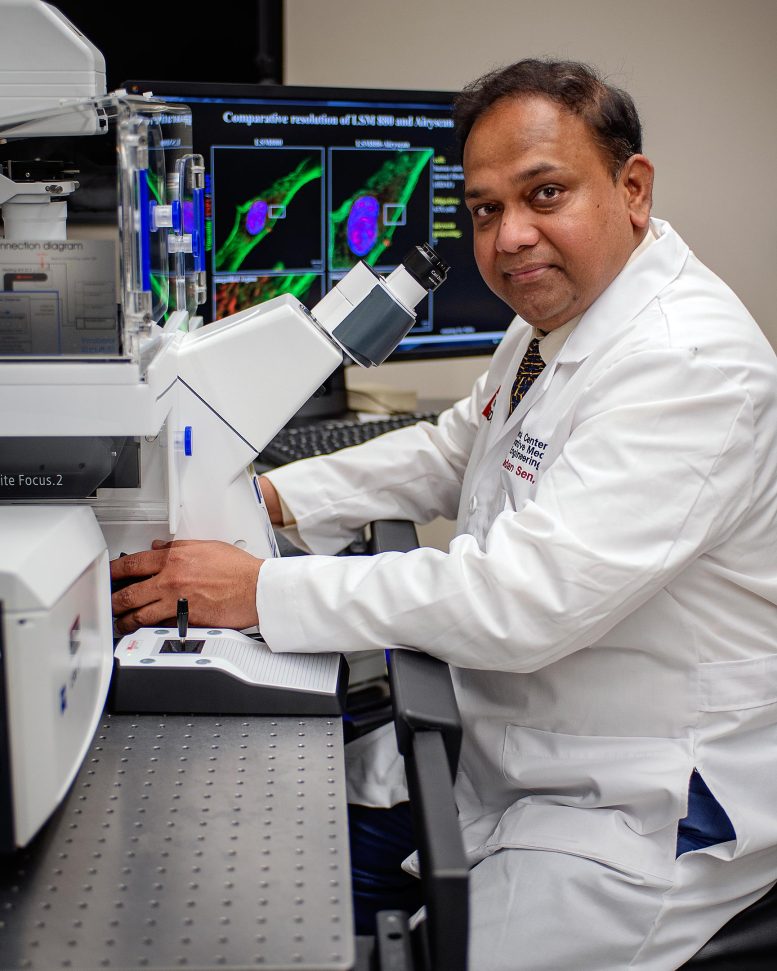
Dr. Chandan Sen holds nanotransfection chip at the Medical Research Library building on Monday November 5, 2018. Chandon Sen, PhD, Indiana Center for Regenerative Medicine and Engineering at the Indiana University School of Medicine. Credit: Indiana University School of Medicine
A silicon device that can change skin tissue into blood vessels and nerve cells has advanced from prototype to standardized fabrication, meaning it can now be made in a consistent, reproducible way. As reported in Nature Protocols, this work, developed by researchers at the Indiana University School of Medicine, takes the device one step closer to potential use as a treatment for people with a variety of health concerns.
The technology, called tissue nanotransfection, is a non-invasive nanochip device that can reprogram tissue function by applying a harmless electric spark to deliver specific genes in a fraction of a second. In laboratory studies, the device successfully converted skin tissue into blood vessels to repair a badly injured leg. The technology is currently being used to reprogram tissue for different kinds of therapies, such as repairing brain damage caused by stroke or preventing and reversing nerve damage caused by diabetes.
“This report on how to exactly produce these tissue nanotransfection chips will enable other researchers to participate in this new development in regenerative medicine,” said Chandan Sen, director of the Indiana Center for Regenerative Medicine and Engineering, associate vice president for research and Distinguished Professor at the IU School of Medicine.

Chandan Sen. Credit: Indiana University School of Medicine
Sen also leads the regenerative medicine and engineering scientific pillar of the IU Precision Health Initiative and is lead author on the new publication.
“This small silicon chip enables nanotechnology that can change the function of living body parts,” he said. “For example, if someone’s blood vessels were damaged because of a traffic accident and they need blood supply, we can’t rely on the pre-existing blood vessel anymore because that is crushed, but we can convert the skin tissue into blood vessels and rescue the limb at risk.”
In the Nature Protocols report, researchers published engineering details about how the chip is manufactured.
Sen said this manufacturing information will lead to further development of the chip in hopes that it will someday be used clinically in many settings around the world.
“This is about the engineering and manufacturing of the chip,” he said. “The chip’s nanofabrication process typically takes five to six days and, with the help of this report, can be achieved by anyone skilled in the art.”
Sen said he hopes to seek FDA approval for the chip within a year. Once it receives FDA approval, the device could be used for clinical research in people, including patients in hospitals, health centers and emergency rooms, as well as in other emergency situations by first responders or the military.

Chandon Sen, PhD, works in his lab at the Indiana Center for Regenerative Medicine and Engineering at the Indiana University School of Medicine. Credit: Indiana University School of Medicine
Reference: “Fabrication and use of silicon hollow-needle arrays to achieve tissue nanotransfection in mouse tissue in vivo” by Yi Xuan, Subhadip Ghatak, Andrew Clark, Zhigang Li, Savita Khanna, Dongmin Pak, Mangilal Agarwal, Sashwati Roy, Peter Duda and Chandan K. Sen, 26 November 2021, Nature Protocols.DOI: 10.1038/s41596-021-00631-0
Other study authors include Yi Xuan, Subhadip Ghatak, Andrew Clark, Zhigang Li, Savita Khanna, Dongmin Pak, Mangilal Agarwal and Sashwati Roy, all of IU, and Peter Duda of the